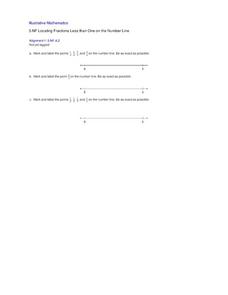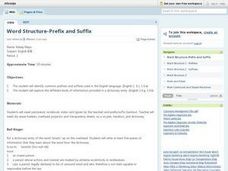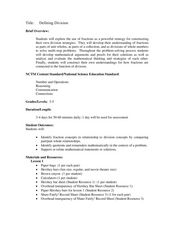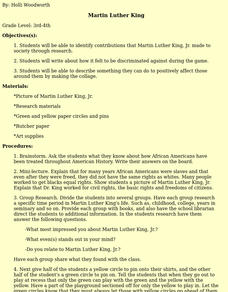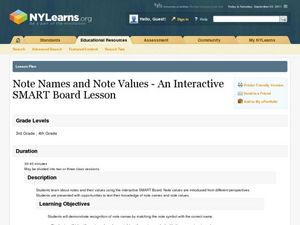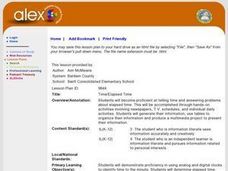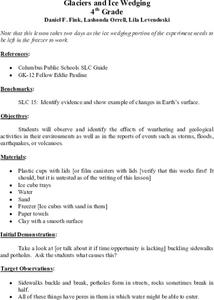Curated OER
Chocolate Math
Students utilize chocolate to identify parts of a whole. In this fractions lesson, students discover the vocabulary associated with fractions and practice dividing a chocolate bar into pieces based on fraction problems....
Curated OER
Body Plans and Adaptations
For this body plans and adaptations worksheet, students will review the different types of symmetry found in organisms. Students will identify body parts as found on either the ventral or dorsal part of an animal. Then students will look...
Curated OER
Equivalent Pals (Fractions)
Fifth graders explore equivalent fractions. In groups, classmates follow instructions to tear paper into fractional parts. Students brainstorm real life items that are equivalent. They model and identify equivalent fractions using...
Curated OER
From Flower to Fruit
Students examine how flowers have essentially four parts. They learn both the male and female reproductive parts of the flower, then explore self-pollination and pollination by insects and other animals.
Curated OER
How Can We Study the Differences in Animal and Plant Cells Using the Compound Microscope?
Young scholars examine their cheek cells with a compound microscope. They identify different parts of the cell. They compare and contrast animal and plant cells with the microscope as well.
Curated OER
A Botanists View
Students explore plant and seed structure. They dissect a seed and identify its parts. In addition, they explain the function and compare and contrast monocotyledon and dicotlyledons.
Illustrative Mathematics
Locating Fractions Less than One on the Number Line
Understanding where to place a fraction on a number line is key to understanding fractions as numbers. This activity focuses on locating fractions less than one. Learners need to partition the line into the correct number of equal sized...
Curated OER
Word Structure- Prefix and Suffix
Identify common prefixes and suffixes used in the English language and categorize the different kinds of information provided in a dictionary entry. Learners will write at least five pieces of information that they learn about a word...
Curated OER
Defining Division
Upper graders explore division through fair-shares. They will review fair shares and fractions as a segway into division. They start by playing "Share Fairly" game and create mathematical arguments for solving problems. Manipulatives and...
Curated OER
Martin Luther King
Identify contributions that Martin Luther King, Jr. made to society through assigning a research project! Third and fourth graders write about how it felt to be discriminated against during the game. They describe something they can do...
Curated OER
Erosion
Fifth graders engage in some activities that will help them to identify erosion and explain the causes of erosion. They also look into ways that humans can slow the process of erosion in some cases. After a teacher-led demonstration,...
Curated OER
Note Names and Note Values - An Interactive Smart Board Lesson
Using the Note Names and Values SMART notebook file, review the whole, half, quarter and eighth note with learners. Students sing "Apple Tree Song." They add body percussion, and then instruments. Learners use the SMART apple tree, they...
EngageNY
Mid-Module Assessment Task: Grade 8 Module 7
Assess pupil understanding of rational and irrational numbers with a mid-module assessment that is the 15th lesson in the 25-part series. The questions represent the objectives in the first half of the series. Topics include decimal...
K12 Reader
The Important Apostrophe: Their, They’re, and There
They're going to be there with their family. Class members practice using and identifying the correct use of they're, there, and their with a skills practice instructional activity. The top half of the instructional activity gives brief...
Curated OER
Time/Elapsed Time
Young mathematicians complete various activities to demonstrate proficiency in telling time and identifying elapsed time. They analyze and discuss television schedules, create a booklet about their daily activities, produce a TV. guide,...
Curated OER
Glaciers and Ice Wedging
Fourth graders observe and identify a variety of weathering and geological activities in the area in which they live. This focuses primarily on what happened during the Ice Age, and how, even today, glaciers are shaping and re-shaping...
Curated OER
Lummi Stick Macarena
Hey, Macarena!! The Macarena is very simple to dance: left, right, left, right, wiggle the hips. Spice it up a bit by giving the class things to hold in their hands such as lummi sticks or scarves. Give them anything that will not be too...
Oregon Department of Education
Building Number Sense
It's never too early to begin a child's math education. This collection of fun hands-on activities engage youngsters in building their number sense as they learn how to count objects, identify numerals, compare amounts, and much more.
Curated OER
All About Seeds!
How do fruits relate to flowers and seeds? Identify the seeds and their purpose with a coloring activity for kindergartners. Once they color the seeds of apples, bananas, and peas (among others), kids get hands-on experience with bean...
NOAA
Technology I
Isn't technology great? The 12th installment of a 23-part NOAA Enrichment in Marine sciences and Oceanography (NEMO) program introduces technology that marine scientists use. Pupils take part in an activity using conductivity,...
Curated OER
The Impact of Cultural Values in EArly Industrial England
Tenth graders analyze works from the period of the Industrial Revolution in England and identify the cultural values depicted and inferred that paved the way for the Industrial Revolution to occur at this time. They create captions that...
Utah Education Network (UEN)
Values
Being self-aware of personal wants, needs, and values is a big part of growing up. Here, you'll find seven different teaching options and two different introductions to a lesson on getting learners to think about their personal values....
Science Geek
Electrochemistry
Introduce redox reactions including how to identify and solve them. After reviewing the rules for assigning oxidation numbers, a presentation presents trends and vocabulary. Finally, it explains voltaic cells, electrolytic cells,...
EngageNY
Rational Numbers on the Number Line
Individuals learn how to plot rational numbers on the number line in the sixth lesson of a 21-part module. They identify appropriate units and determine opposites of rational numbers.






